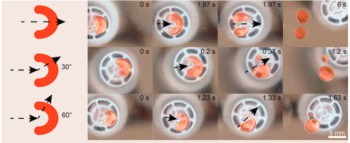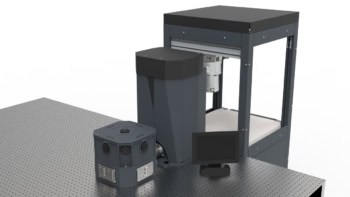Cavitation is an unusual process whereby tiny air bubbles grow and collapse inside water droplets. It can be a big problem in industry, where it can erode everything from ship propellors to pipelines. Now, however, researchers in Europe have obtained new insights into this process -- by studying cavitation in space. The work let them create isolated, spherical droplets of water that would be impossible to make on Earth (Phys. Rev. Lett. 97 094502)
Cavitation is a problem in industry because the collapsing bubbles that form during this process focus energy to very small volumes, creating temperature “hotspots” and emitting liquid jets and shockwaves. Cavitation does, however, have a good side, being used to kill bacteria, destroy kidney stones and clean surfaces.
Recent studies have shown that the behaviour of single bubbles depends strongly on any nearby surfaces — for example, whether they collapse next to flat or curved rigid surfaces. Researchers are now keen to see how bubbles behave inside spherical drops of water and interact with closed spherical surfaces. Unfortunately, it is impossible to do this in the lab for centimetre-sized drops, because gravity forces the surface between the liquid and air to be flat.
Philippe Kobel from the EPFL in Lausanne, Switzerland, and co-workers have got round this problem by creating such bubbles in space. They put their experiment on board a special European Space Agency aircraft, which flew in parabolic arcs, climbing and falling to create near-weightless conditions within the aircraft for 20 seconds at a time.
The experiment involved slowly expelling the drops through a special tube and generating bubbles inside the drops by a spark discharge between two thin electrodes immersed in the drop. These microgravity conditions allowed them to create centimetre-sized spherical drops of water, which were then studied using a high-speed CCD camera.
Kobel’s team made several unusual findings. In particular, they discovered that a bubble that is formed not exactly in the centre of the drop — but to one side — collapses with toroidal symmetry and generates two liquid jets that escape from the drop in opposite directions. This is the first direct visualization of two bubble-induced jets escaping from a steady liquid volume.
The researchers have also studied the “mist” of tiny, sub-millimetre “microbubbles” that are often created within bubbles in cavitation experiment. They reckon these microbubbles are themselves cavities, created because the primary shock wave (emitted by the spark triggering the bubble growth) excites microscopic impurities and dissolved gas in the liquid.
The researchers have even been able to extend current theory to estimate shockwave energies and calculate bubble lifetimes in small liquid volumes that can appear in industrial systems. Their experiment may also cast light on spherical collapse and shock-wave phenomena in supernovae, as it provides a simplified situation of shockwaves propagating inside fluid spheres.



